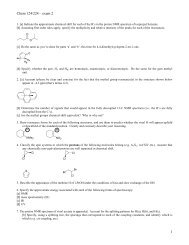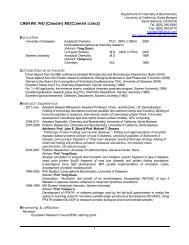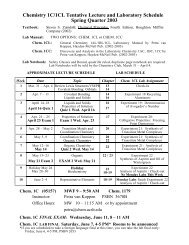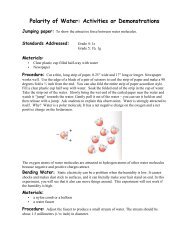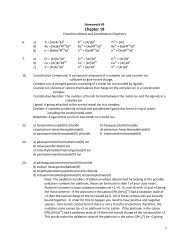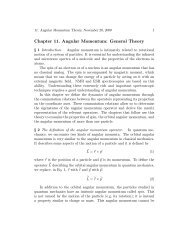Chapter 7. The Eigenvalue Problem
Chapter 7. The Eigenvalue Problem
Chapter 7. The Eigenvalue Problem
You also want an ePaper? Increase the reach of your titles
YUMPU automatically turns print PDFs into web optimized ePapers that Google loves.
<strong>7.</strong> <strong>The</strong> <strong>Eigenvalue</strong> <strong>Problem</strong>, December 17, 2009 4<br />
When λ i = λ j ,wemusthave<br />
η i | η j =0,<br />
which is what we wanted to prove.<br />
So, when you solve an eigenvalue equation for an observable, the eigenstates<br />
corresponding to different eigenvalues must be orthogonal. If they are<br />
not, there is something wrong with the program calculating the eigenvectors.<br />
What happens if some eigenvalues are equal to each other Physicists<br />
call such eigenvalues ‘degenerate’, mathematicians call them ‘multiple’. If |η i <br />
and |η j belong to the same eigenvalue (i.e. if Â|η i = λ|η i and Â|η j = λ|η j )<br />
then |η i and |η j are under no obligation to be orthogonal to each other (only<br />
to, according to the fact in the previous §, all eigenvectors belonging to eigenvalues<br />
that differ from λ). Most numerical procedures for solving eigenvalue<br />
problems will provide non-orthogonal degenerate eigenvectors. <strong>The</strong>se can be<br />
orthogonalized with the Gram-Schmidt procedure and then normalized. <strong>The</strong><br />
resulting eigenvectors are now pure states. You will see how this is done in<br />
an example given later in this chapter.<br />
It is important to keep in mind this distinction between eigenstates and<br />
pure states. All pure states are eigenstates but not all eigenstates are pure<br />
states.<br />
§ 5 <strong>The</strong> eigenvalue problem in matrix representation: a review. Let |a 1 ,<br />
|a 2 , ..., |a n , ...be a complete orthonormal basis set. This set need not be<br />
a set of pure states of an observable; we can use any complete basis set that<br />
a mathematician can construct. Orthonormality means that<br />
Because the set is complete, we have<br />
a i | a j = δ ij for all i, j (16)<br />
Î <br />
N<br />
|a n a n | (17)<br />
n=1<br />
Eq. 17 ignores the continuous spectrum and truncates the infinite sum in the<br />
completeness relation.<br />
We can act with each a m |, m =1, 2,...,N, on the eigenvalue equation<br />
to turn it into the following N equations:<br />
a m | Â | ψ = λa m | ψ, m =1, 2,...,N (18)




